9 Different Descriptive Settings to Use In Your Fantasy Novel (Without Using Forests)
Has anyone else here noticed that forests always show up in fantasy novels? I have. It seems that almost every fantasy book I've ever read is either set in a forest or has characters that spend a large amount of time living in or traveling through a forest.
Incidentally, these forests are generally made up of only trees and, if the writer is feeling really creative, or wants to scrape up their character a bit, this large group of trees may also have "bramble."
Occasionally you get a mountain or two, generally some kind of rebel base with treacherous paths. And maybe a forest at the base. Because forests are the lifeblood of fantasy novels.
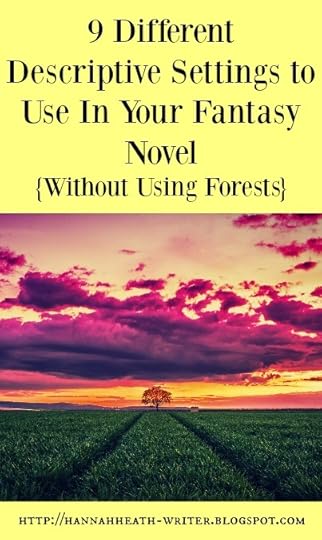 But what about tundras, guys? Or deserts? Or meadows? Or beaches or prairies, wetlands, glaciers, jungles, rice terraces, vales? What about those? Why don't those ever make it into books?
But what about tundras, guys? Or deserts? Or meadows? Or beaches or prairies, wetlands, glaciers, jungles, rice terraces, vales? What about those? Why don't those ever make it into books?
Stop the descriptive setting discrimination! Kill your forestcentricity. If you find yourself in the middle of building a fantasy world, stop and think about what you want to world to look like. Do you want it to be one big mess of forests, with the occasional mountain and river? Or do you want it to be a developed world with interesting terrains for your character to traverse?
If you said yes to the latter, here are some interesting and underused settings to use in your fantasy novel:
1. KarstsA karst is a landscape formed from the erosion of limestone (or other soluble stone), producing underground rivers, towers, caves, and sinkholes. They're quite beautiful, and can exist both inland and right on (or in) an ocean or lake: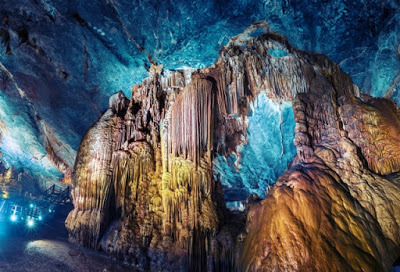
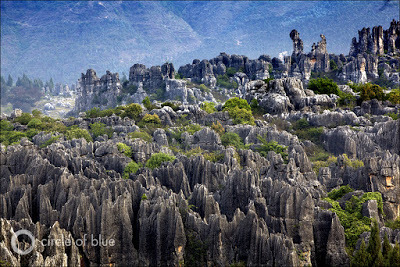 They can be dangerous, as sometimes the ground can be eroding right beneath you and you won't even know it. People fall through the ground or get their houses sucked into a massive rabbit hole. On the upside, they're great for spelunking. I'm sure Lucius Fox could set you up.
They can be dangerous, as sometimes the ground can be eroding right beneath you and you won't even know it. People fall through the ground or get their houses sucked into a massive rabbit hole. On the upside, they're great for spelunking. I'm sure Lucius Fox could set you up.
2. Cold DesertsWe all know about sandy, windy, hot deserts. But what about cold deserts? Technically, a desert isn't just a dry, hot place. It's defined as a barren area of land with harsh living conditions and very little precipitation. That's right, folks. Antarctica is a desert. That being said, cold deserts aren't necessarily just miles and miles of ice and snow. They can have sturdy shrubs, wildflowers, and lichen, among other things. Take a look: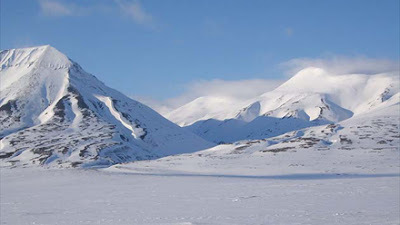
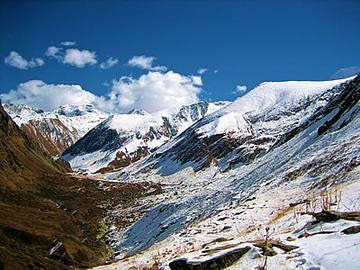
3. Tropical RainforestsI'm always surprised at how anything tropics-related never make it into fantasy novels. I think it has to do with the fact that many fantasy books are eurocentric, a topic that A.Z. Anthony wrote about here (don't forget to follow his blog while you're over there. It's great). But, honestly, tropical rainforests are beautiful. I'm not including pictures because there were too many gorgeous ones and I couldn't decide which to put in. Also, I'm pretty sure we've all heard of tropical rainforests. If not, go google it.
4. Salt FlatsLarge areas of flat land covered in salt, this is one of the parts of our world that looks like it might belong on another planet: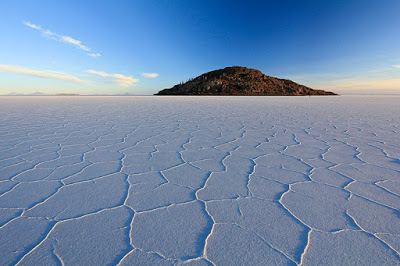 Think of the economical impact this could have in a fictional world. Forget the kingdom with the jewel mines. Think how powerful a king would be if he monopolized the largest salt flats in the world. Salt could become a type of currency. Pretty interesting, right?
Think of the economical impact this could have in a fictional world. Forget the kingdom with the jewel mines. Think how powerful a king would be if he monopolized the largest salt flats in the world. Salt could become a type of currency. Pretty interesting, right?
5. WetlandsGenerally, these show up in books as massive bogs full of dead people and flies that like to eat hobbit. While they can be dangerous, they can also be beautiful.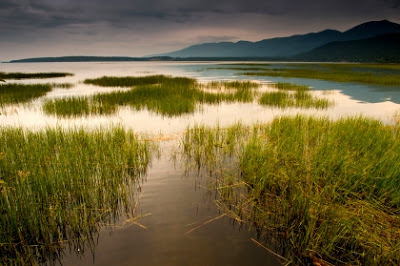 In a fictional world, a wetland could be a very prosperous area where special foods are grown. But sure, they could also be the place where all your exiles are cast into.
In a fictional world, a wetland could be a very prosperous area where special foods are grown. But sure, they could also be the place where all your exiles are cast into.
6. ArchipelagosThis, to me, was one of my favorite parts of The Wizards of Earthsea by Ursula K. Le Guin. Wizards running around islands and sailing boats? Yes, please! Not only are archipelagos beautiful, but they have a vast array of interesting creatures: fish, sharks, corals, sea stars, gulls. It's also worth noting that some peoples prefer to live near an archipelago, but not actually on them. Which means they live in boats or houses anchored off shore. Think of the possibilities: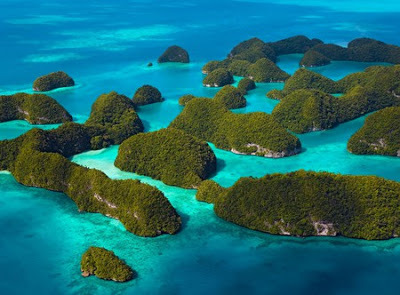
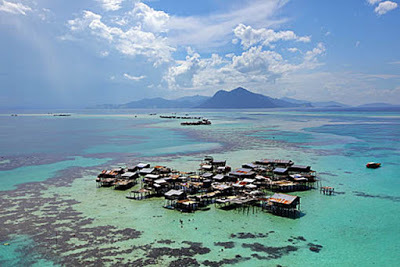 If you have time and are searching for writing inspiration, look up the Bajau Laut. They're actual sea nomads. It's amazing.
If you have time and are searching for writing inspiration, look up the Bajau Laut. They're actual sea nomads. It's amazing.
7. TundrasA region where the sub soil is always frozen or semi-frozen. There are no trees and, because of how windy tundras generally are, all of the plants grow very low to the ground.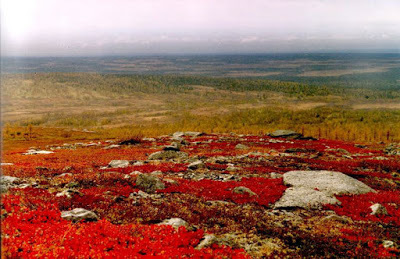 The tundra that I've been to (Glacier National Park in Montana) had beautiful little flowers all over the place, along with very short grass. And marmots. Don't forget about the marmots.
The tundra that I've been to (Glacier National Park in Montana) had beautiful little flowers all over the place, along with very short grass. And marmots. Don't forget about the marmots.
8. Mesas, Buttes, Hoodoos, and SpiresI don't know exactly what category these fall into. What? I only pretend to know everything. But, regardless of what geological subset they belong to, these are amazing. They're stunning soft rock formations carved out by wind or water, and can often be vibrant reds. Utah has some amazing ones that I've seen in person, but they can be found all over the world.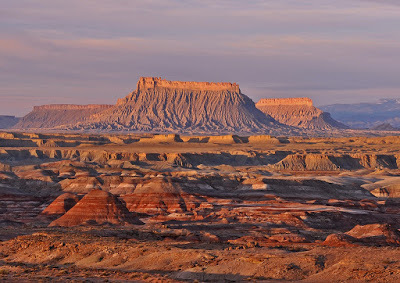
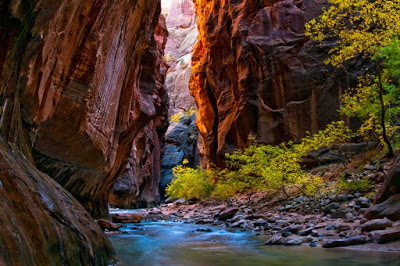 Look up Zion National Park, specifically Angels Landing and The Narrows. That place is possibly the most gorgeous place I've been to date. I can't begin to explain to you how many story ideas it holds. So go look at pictures...or, if possible, visit it.
Look up Zion National Park, specifically Angels Landing and The Narrows. That place is possibly the most gorgeous place I've been to date. I can't begin to explain to you how many story ideas it holds. So go look at pictures...or, if possible, visit it.
9. MangrovesThese are really, really cool. It's a tidal habitat comprised of mangrove trees, which are trees that have roots both above and below ground, forming dense thickets.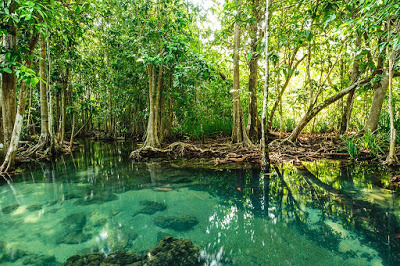
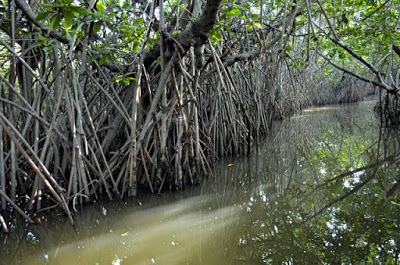 Not only could they make interesting houses, but I imagine they'd be a good way to drown people: stick 'em beneath the roots and wait for the tide to rise. What? I'm a writer. It's my job to think of stuff like that. Also, this is my way of making people think twice before leaving me angry comments. Just kidding.
Not only could they make interesting houses, but I imagine they'd be a good way to drown people: stick 'em beneath the roots and wait for the tide to rise. What? I'm a writer. It's my job to think of stuff like that. Also, this is my way of making people think twice before leaving me angry comments. Just kidding.
There are many, many other beautiful places to draw from. Steppes, dunes, mud flats, lava domes, glaciers, vales, many different kinds of mountains, deltas. Look them up.
My point isn't that you can't have forests in your fantasy novels. However, you should take some time to think about the world around you. It's vast and gorgeous and complex in so many different ways. Don't you want that reflected in your fantasy world? A unique descriptive setting is a great way to do this.
What do you think? Of all the settings listed above, which was your favorite? Which of them do you have in your book or will probably put in your book? I'd love to hear your thoughts!
Related items: 8 Tips to Improve Your Descriptive Writing7 Tips for Choosing Your Character's Appearance
Enjoy this post? Take a look around. If you like what you see, don't forget to subscribe by email for a new post every Friday!SaveSave
SaveSaveSaveSave
Incidentally, these forests are generally made up of only trees and, if the writer is feeling really creative, or wants to scrape up their character a bit, this large group of trees may also have "bramble."
Occasionally you get a mountain or two, generally some kind of rebel base with treacherous paths. And maybe a forest at the base. Because forests are the lifeblood of fantasy novels.
 But what about tundras, guys? Or deserts? Or meadows? Or beaches or prairies, wetlands, glaciers, jungles, rice terraces, vales? What about those? Why don't those ever make it into books?
But what about tundras, guys? Or deserts? Or meadows? Or beaches or prairies, wetlands, glaciers, jungles, rice terraces, vales? What about those? Why don't those ever make it into books?Stop the descriptive setting discrimination! Kill your forestcentricity. If you find yourself in the middle of building a fantasy world, stop and think about what you want to world to look like. Do you want it to be one big mess of forests, with the occasional mountain and river? Or do you want it to be a developed world with interesting terrains for your character to traverse?
If you said yes to the latter, here are some interesting and underused settings to use in your fantasy novel:
1. KarstsA karst is a landscape formed from the erosion of limestone (or other soluble stone), producing underground rivers, towers, caves, and sinkholes. They're quite beautiful, and can exist both inland and right on (or in) an ocean or lake:

 They can be dangerous, as sometimes the ground can be eroding right beneath you and you won't even know it. People fall through the ground or get their houses sucked into a massive rabbit hole. On the upside, they're great for spelunking. I'm sure Lucius Fox could set you up.
They can be dangerous, as sometimes the ground can be eroding right beneath you and you won't even know it. People fall through the ground or get their houses sucked into a massive rabbit hole. On the upside, they're great for spelunking. I'm sure Lucius Fox could set you up. 2. Cold DesertsWe all know about sandy, windy, hot deserts. But what about cold deserts? Technically, a desert isn't just a dry, hot place. It's defined as a barren area of land with harsh living conditions and very little precipitation. That's right, folks. Antarctica is a desert. That being said, cold deserts aren't necessarily just miles and miles of ice and snow. They can have sturdy shrubs, wildflowers, and lichen, among other things. Take a look:


3. Tropical RainforestsI'm always surprised at how anything tropics-related never make it into fantasy novels. I think it has to do with the fact that many fantasy books are eurocentric, a topic that A.Z. Anthony wrote about here (don't forget to follow his blog while you're over there. It's great). But, honestly, tropical rainforests are beautiful. I'm not including pictures because there were too many gorgeous ones and I couldn't decide which to put in. Also, I'm pretty sure we've all heard of tropical rainforests. If not, go google it.
4. Salt FlatsLarge areas of flat land covered in salt, this is one of the parts of our world that looks like it might belong on another planet:
 Think of the economical impact this could have in a fictional world. Forget the kingdom with the jewel mines. Think how powerful a king would be if he monopolized the largest salt flats in the world. Salt could become a type of currency. Pretty interesting, right?
Think of the economical impact this could have in a fictional world. Forget the kingdom with the jewel mines. Think how powerful a king would be if he monopolized the largest salt flats in the world. Salt could become a type of currency. Pretty interesting, right? 5. WetlandsGenerally, these show up in books as massive bogs full of dead people and flies that like to eat hobbit. While they can be dangerous, they can also be beautiful.
 In a fictional world, a wetland could be a very prosperous area where special foods are grown. But sure, they could also be the place where all your exiles are cast into.
In a fictional world, a wetland could be a very prosperous area where special foods are grown. But sure, they could also be the place where all your exiles are cast into. 6. ArchipelagosThis, to me, was one of my favorite parts of The Wizards of Earthsea by Ursula K. Le Guin. Wizards running around islands and sailing boats? Yes, please! Not only are archipelagos beautiful, but they have a vast array of interesting creatures: fish, sharks, corals, sea stars, gulls. It's also worth noting that some peoples prefer to live near an archipelago, but not actually on them. Which means they live in boats or houses anchored off shore. Think of the possibilities:

 If you have time and are searching for writing inspiration, look up the Bajau Laut. They're actual sea nomads. It's amazing.
If you have time and are searching for writing inspiration, look up the Bajau Laut. They're actual sea nomads. It's amazing. 7. TundrasA region where the sub soil is always frozen or semi-frozen. There are no trees and, because of how windy tundras generally are, all of the plants grow very low to the ground.
 The tundra that I've been to (Glacier National Park in Montana) had beautiful little flowers all over the place, along with very short grass. And marmots. Don't forget about the marmots.
The tundra that I've been to (Glacier National Park in Montana) had beautiful little flowers all over the place, along with very short grass. And marmots. Don't forget about the marmots. 8. Mesas, Buttes, Hoodoos, and SpiresI don't know exactly what category these fall into. What? I only pretend to know everything. But, regardless of what geological subset they belong to, these are amazing. They're stunning soft rock formations carved out by wind or water, and can often be vibrant reds. Utah has some amazing ones that I've seen in person, but they can be found all over the world.

 Look up Zion National Park, specifically Angels Landing and The Narrows. That place is possibly the most gorgeous place I've been to date. I can't begin to explain to you how many story ideas it holds. So go look at pictures...or, if possible, visit it.
Look up Zion National Park, specifically Angels Landing and The Narrows. That place is possibly the most gorgeous place I've been to date. I can't begin to explain to you how many story ideas it holds. So go look at pictures...or, if possible, visit it. 9. MangrovesThese are really, really cool. It's a tidal habitat comprised of mangrove trees, which are trees that have roots both above and below ground, forming dense thickets.

 Not only could they make interesting houses, but I imagine they'd be a good way to drown people: stick 'em beneath the roots and wait for the tide to rise. What? I'm a writer. It's my job to think of stuff like that. Also, this is my way of making people think twice before leaving me angry comments. Just kidding.
Not only could they make interesting houses, but I imagine they'd be a good way to drown people: stick 'em beneath the roots and wait for the tide to rise. What? I'm a writer. It's my job to think of stuff like that. Also, this is my way of making people think twice before leaving me angry comments. Just kidding. There are many, many other beautiful places to draw from. Steppes, dunes, mud flats, lava domes, glaciers, vales, many different kinds of mountains, deltas. Look them up.
My point isn't that you can't have forests in your fantasy novels. However, you should take some time to think about the world around you. It's vast and gorgeous and complex in so many different ways. Don't you want that reflected in your fantasy world? A unique descriptive setting is a great way to do this.
What do you think? Of all the settings listed above, which was your favorite? Which of them do you have in your book or will probably put in your book? I'd love to hear your thoughts!
Related items: 8 Tips to Improve Your Descriptive Writing7 Tips for Choosing Your Character's Appearance
Enjoy this post? Take a look around. If you like what you see, don't forget to subscribe by email for a new post every Friday!SaveSave
SaveSaveSaveSave

Published on November 11, 2016 06:30
No comments have been added yet.



